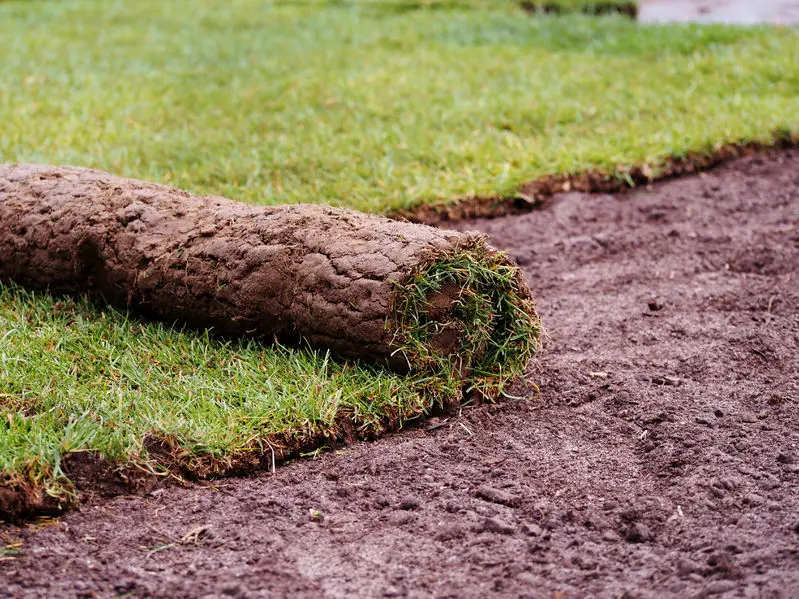Laying turf on clay soil can be challenging, but when done correctly, it produces a lush, green lawn that thrives for years. Clay soil, with its dense texture and poor drainage, often frustrates gardeners, but it also has advantages when managed properly. The key lies in preparing the soil thoroughly and creating the right conditions for root establishment.
This detailed guide explains how to lay turf on clay soil the right way, ensuring perfect growth and a healthy, long-lasting lawn.
Table of Contents
Understanding the Nature of Clay Soil

Before preparing to lay turf, it is important to understand the characteristics of clay soil. Clay soil contains extremely fine particles that hold moisture tightly, making it prone to waterlogging in wet weather and compaction when dry. Because of this, lawns laid directly on untreated clay often suffer from poor drainage, shallow roots, and patchy grass.
However, clay soil is naturally rich in minerals and nutrients. When properly amended, it can support strong turf growth because it retains moisture and nutrients better than sandy or loamy soils. The challenge lies in loosening the compacted texture and improving drainage to encourage deeper root penetration.
Preparing Clay Soil for Turf Installation
Assessing the Existing Soil Condition
The first step in preparing clay soil for turf is assessing its current state. Testing how compacted the soil is, checking for drainage issues, and understanding its pH level can help determine the necessary amendments. Clay soil often leans slightly acidic or neutral, which is generally suitable for turfgrass, but compaction must be addressed for successful growth.
Improving Soil Structure for Better Root Penetration
Breaking up the dense clay structure is crucial before laying turf. Digging or cultivating the soil to a depth of at least 10 to 15 centimeters helps loosen compacted layers, allowing air, water, and roots to move more freely. Adding organic matter, such as compost or well-rotted manure, improves soil texture by creating channels that enhance drainage and aeration. The organic material gradually breaks down, increasing microbial activity and making the soil more friable over time.
In areas with extremely heavy clay, mixing in coarse sand or grit alongside organic matter can further improve soil structure. However, excessive sand can create a cement-like texture when combined with clay, so organic matter remains the most effective long-term solution.
Leveling and Grading the Soil Surface
Once the clay has been loosened and amended, the soil should be leveled to create an even surface for turf installation. Proper grading ensures water flows away from the lawn rather than pooling in low spots. Slightly sloping the soil away from buildings and pathways prevents drainage problems that could harm the turf.
A firm but not compacted surface is ideal. Lightly treading or rolling the soil after leveling helps create a stable base without crushing the improved structure.
Choosing the Right Turf for Clay Soil
Not all turf varieties perform equally well on clay soil. Selecting grass types that tolerate heavier soils and fluctuating moisture levels ensures long-term success. Many cool-season grasses, such as fescues and ryegrass, adapt well to clay because of their strong root systems and ability to thrive in nutrient-rich environments. In warmer regions, Bermuda grass and zoysia can also perform well when soil structure is improved.
Opting for high-quality turf rolls with healthy, thick roots increases the chances of quick establishment. Freshly harvested turf with moist, intact roots is far more likely to adapt to clay soil conditions than older, dried-out turf.
Laying Turf on Clay Soil for Best Results
Proper Turf Placement and Alignment
Laying turf on clay soil requires precision to ensure seamless coverage and even growth. Turf rolls should be placed tightly together without overlapping to prevent gaps and uneven rooting. Staggering the joints in a brickwork pattern minimizes visible lines and helps the lawn knit together faster.
Ensuring good contact between the turf and soil is essential. Pressing or lightly rolling the turf after laying removes air pockets, allowing roots to anchor firmly into the amended clay base.
Watering Immediately After Installation
Adequate watering immediately after laying turf is crucial for root establishment, especially on clay soil, which can dry out and crack on the surface while retaining moisture beneath. Deep watering helps the roots penetrate the loosened soil, reducing the risk of shallow rooting.
For the first few weeks, consistent moisture is essential, but overwatering should be avoided, as saturated clay can suffocate roots. Monitoring soil moisture and adjusting irrigation based on weather conditions ensures the best results.
Caring for New Turf on Clay Soil
Encouraging Deep Root Growth
Establishing strong, deep roots is the key to long-term turf success on clay soil. Once the initial establishment period passes, watering should be less frequent but deeper to encourage roots to grow downward in search of moisture. Shallow, frequent watering promotes weak roots that struggle in clay soil.
Fertilizing the new turf after about six weeks with a balanced, slow-release fertilizer supports root and leaf development. Nitrogen promotes lush growth, while phosphorus encourages stronger root systems, which is particularly beneficial for clay soil adaptation.
Mowing Practices for Healthy Turf
Mowing the turf for the first time should only occur once it reaches around 7 to 8 centimeters in height. Cutting too early can stress young roots, especially in clay, where establishment may take slightly longer. A sharp mower blade is essential to avoid tearing the grass, and only one-third of the grass height should be removed at a time.
Regular mowing after establishment encourages thicker growth and helps the turf spread more evenly across the clay soil surface.
Improving Clay Soil Long-Term for Turf Health
Clay soil continues to change over time, and ongoing maintenance ensures the lawn remains healthy for years. Topdressing the lawn annually with a mixture of sand, loam, and organic matter gradually improves soil structure and drainage. Aeration, performed at least once a year, relieves compaction by creating small holes that allow air, water, and nutrients to penetrate deeper.
Overseeding thin patches after aeration keeps the lawn dense and minimizes weed invasion. Combining these practices with proper watering and fertilizing maintains a strong, resilient lawn even on challenging clay soil.
Common Problems and Solutions for Turf on Clay Soil
Dealing with Waterlogging Issues
One of the most common problems with turf on clay soil is waterlogging. If puddles form after heavy rain, improving surface drainage and regularly aerating the lawn can help. Avoiding excessive watering is equally important, as saturated clay can lead to root diseases and fungal issues.
Managing Compaction Over Time
Foot traffic gradually compacts clay soil, reducing aeration and root growth. Core aeration and regular topdressing counteract compaction, keeping the soil structure open and encouraging deeper root systems. Avoiding heavy machinery or frequent walking on wet clay further prevents compaction.
Addressing Yellowing or Poor Growth
Yellowing grass or patchy growth often indicates nutrient deficiencies or poor drainage. Applying a suitable fertilizer and checking soil pH can correct nutrient imbalances, while improving aeration and drainage addresses root health issues.
FAQs about Laying Turf on Clay Soil
Can you lay turf directly on clay soil?
Yes, but clay soil must be properly prepared by loosening, improving drainage, and adding organic matter to ensure strong turf root growth.
What is the best turf for clay soil?
Grass types with strong root systems, such as fescues, ryegrass, or Bermuda grass, adapt well to clay soil when the structure is improved.
How do you prepare clay soil before laying turf?
Clay soil should be loosened, enriched with compost or organic matter, and leveled to improve drainage and aeration before turf installation.
How often should you water new turf on clay soil?
Water deeply after laying turf, then keep the soil consistently moist for the first few weeks. Avoid overwatering to prevent waterlogging.
How long does turf take to establish on clay soil?
Turf usually takes three to six weeks to establish on clay soil, depending on weather, watering, and soil preparation quality.
Final Thoughts on Laying Turf on Clay Soil
Laying turf on clay soil may require extra effort, but the rewards are worth it. With proper preparation, soil improvement, and ongoing care, clay soil can support a lush, healthy lawn that lasts for years. By loosening the dense soil, adding organic matter, selecting the right turf, and maintaining consistent care, gardeners can transform challenging clay areas into thriving green spaces. Patience and good lawn care practices are the ultimate secrets to achieving perfect turf growth on clay soil.






